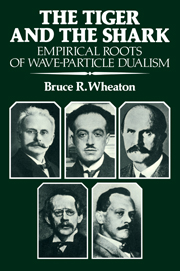Book contents
- Frontmatter
- Contents
- Foreword by Thomas S. Kuhn
- Preface
- Notes on sources
- 1 Introduction
- Part I The introduction of temporal discontinuity, 1896–1905
- Part II Ionization and the recognition of paradox, 1906–1910
- Part III Seeking an electrodynamic solution, 1907–1912
- 6 Localized energy in spreading impulses
- 7 Problems with visible light
- Part IV Interference of x-rays and the corroboration of paradox, 1912–1922
- Part V The conceptual origins of wave–particle dualism, 1921–1925
- Epilogue: The tiger and the shark
- Bibliography
- Index
7 - Problems with visible light
Published online by Cambridge University Press: 04 August 2010
- Frontmatter
- Contents
- Foreword by Thomas S. Kuhn
- Preface
- Notes on sources
- 1 Introduction
- Part I The introduction of temporal discontinuity, 1896–1905
- Part II Ionization and the recognition of paradox, 1906–1910
- Part III Seeking an electrodynamic solution, 1907–1912
- 6 Localized energy in spreading impulses
- 7 Problems with visible light
- Part IV Interference of x-rays and the corroboration of paradox, 1912–1922
- Part V The conceptual origins of wave–particle dualism, 1921–1925
- Epilogue: The tiger and the shark
- Bibliography
- Index
Summary
The speaker does not wish to deny the heuristic value of the [lightquantum] hypothesis, only to defend the [classical] theory as long as possible.
Between 1909 and 1912, many influential physicists first realized that the problems preventing a consistent understanding of x-rays applied as well to ordinary light. But unlike the relatively new impulse theory of x-rays, the wave theory of light was exceedingly well founded. It rested on a century's accumulation of experimental evidence. Spatial concentration in the energy of light could not be attributed to a temporal discontinuity, as it could for x-ray impulses. Light was known to be a repeating periodic wave. It was not fully realized at first that hypotheses about the nature of ordinary light required modification. For a decade after 1910, the significance of the growing empirical evidence favoring spatial localization of luminous energy went largely unrecognized. This occurred because the data ran counter to the orthodox view of visible light, the spectral region wherein the periodic properties of radiation were most easily demonstrated and most firmly established.
H. A. Lorentz attacked the problem in much the same spirit, but with quite the opposite intent, as had Einstein. He showed in 1909 that the lightquantum hypothesis is incompatible with the quantum transformation relation itself, let alone with classical ideas about radiation. In so doing, he laid the foundation for a restatement of a major difficulty with any classical explanation of the photoelectric effect: It takes an extraordinarily long time for the observed quantity of energy to build up from periodic waves incident on an electron.
Information
- Type
- Chapter
- Information
- The Tiger and the SharkEmpirical Roots of Wave-Particle Dualism, pp. 168 - 196Publisher: Cambridge University PressPrint publication year: 1983
